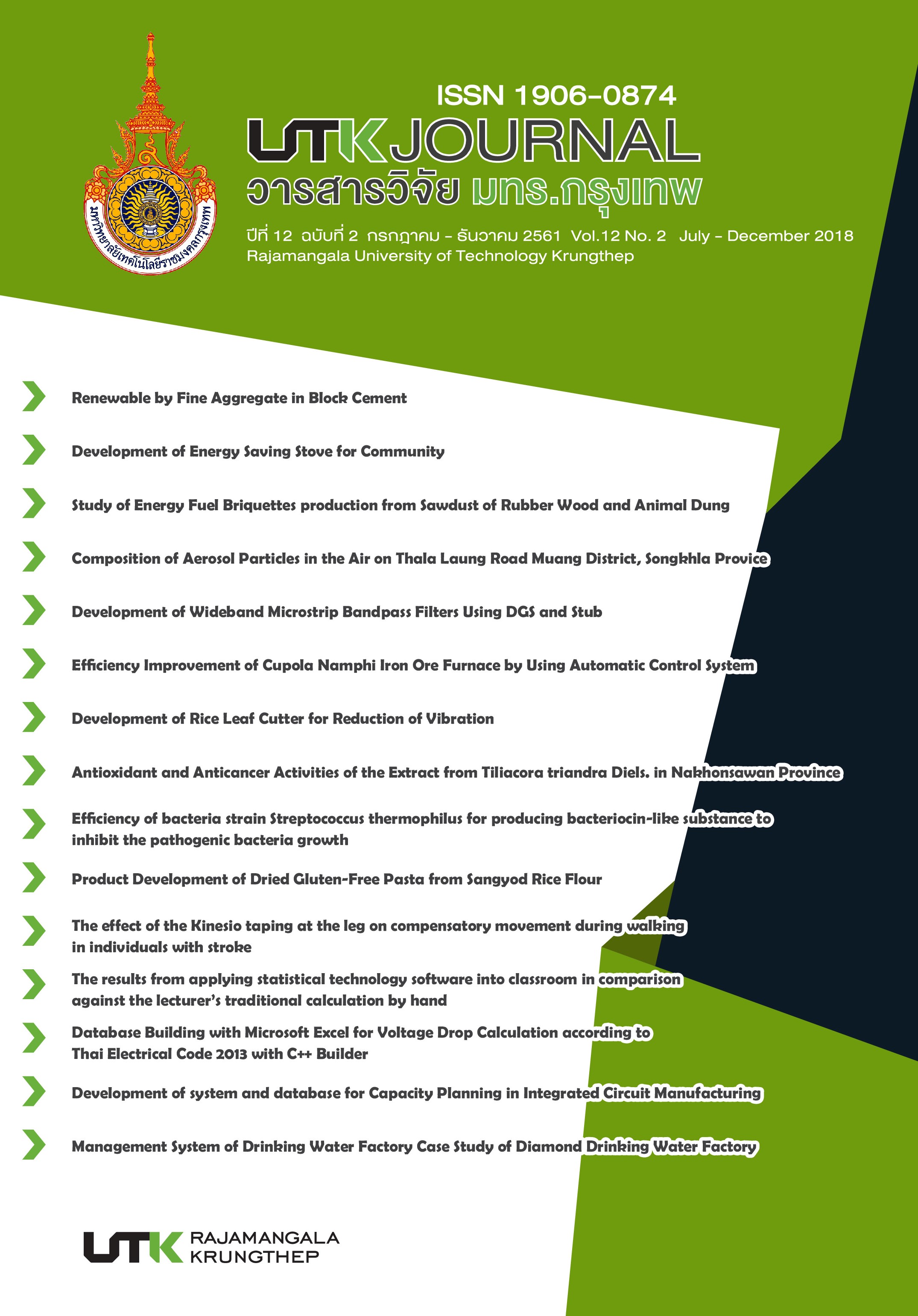การพัฒนาผลิตภัณฑ์เส้นพาสต้าปราศจากกลูเตนอบแห้งจากแป้งข้าวสังข์หยด
คำสำคัญ:
พาสต้าปราศจากกลูเตน, ไฮโดรคอลลอยด์, แซนแทนกัม, อบแห้ง, แปูงข้าวสังข์หยดบทคัดย่อ
งานวิจัยนี้มีวัตถุประสงค์เพื่อทำการพัฒนาผลิตภัณฑ์เส้นพาสต้าปราศจากกลูเตนแบบแห้งจากแป้งข้าวสังข์หยด โดยการศึกษาปริมาณแซนแทนกัมที่เหมาะสมต่อการปรับปรุงคุณภาพเส้นพาสต้าปราศจากกลูเตน โดยเติมแซนแทนกัม 0, 1, 1.5, 2 และ 2.5 กรัม/100 กรัมของแป้งข้าวสังข์หยด พบว่าน้ำหนักหลังปรุงสุกมีแนวโน้มเพิ่มขึ้นและการสูญเสียน้ำหนักระหว่างปรุงสุกมีแนวโน้มลดลงเมื่อแซนแทนกัมที่ระดับสูงขึ้น โดยเส้นพาสต้าที่เติมแซนแทนกัมร้อยละ 1.5 มีคะแนนความชอบด้านลักษณะปรากฏ สี กลิ่น กลิ่นรส เนื้อสัมผัส และความชอบโดยรวมสูงที่สุด เมื่อศึกษาระยะเวลาในการให้ความร้อนเบื้องต้นต่อเส้นพาสต้าที่อุณหภูมิ 80±5 องศาเซลเซียส เป็นเวลา 2, 4 และ 6 นาที และอบแห้งที่อุณหภูมิ 60 และ 80 องศาเซลเซียส พบว่าน้ำหนักหลังปรุงสุก และความสามารถในการดูดซับน้ำของเส้นพาสต้าที่อบแห้งด้วยอุณหภูมิ 60 องศาเซลเซียส มีค่าลดลง (p<0.05) เมื่อระยะเวลาในการให้ความร้อนเพิ่มขึ้น ในขณะที่เส้นพาสต้าที่อบด้วยอุณหภูมิ 80 องศาเซลเซียส มีค่าน้ำหนักหลังปรุงสุก และความสามารถในการดูดซับน้ำไม่แตกต่างกัน (p≥0.05) เมื่อระยะเวลาในการให้ความร้อนเพิ่มขึ้น อย่างไรก็ตามเมื่ออุณหภูมิในการอบแห้งเพิ่มสูงขึ้นส่งผลให้เส้นพาสต้ามีน้ำหนักหลังปรุงสุก และความสามารถในการดูดซับน้ำลดน้อยลง โดยเส้นพาสต้าที่อบแห้งด้วยอุณหภูมิสูงจะมีค่าความแข็งแรงในการตัดขาด และคะแนนความชอบโดยรวมสูงกว่าเส้นพาสต้าที่อบแห้งด้วยอุณหภูมิต่ำ
เอกสารอ้างอิง
[2] Giuberti G., Antonio G., Carla C., et al. Cooking quality and starch digestibility of gluten free pasta using new bean flour. Food Chem 2015; 175:43–49.
[3] Mirhosseini H., Abdul Rashid NF., Amid BT., et al. Effect of partial replacement of corn flour with durian Seed flour and pumpkin flour on cooking yield, texture properties, and sensory attributes of gluten free pasta. LWT - Food Sci and Tech 2015; 63:184-190.
[4] Sila MRF., Ana Paula M., Mônica CRA., et al. Utilization of sorghum, rice, corn flours with potato starch for the preparation of gluten-free pasta. Food Chem 2016; 191:147–151.
[5] Udachan IS., Sahoo AK.. Effect of hydrocolloids in the development of gluten free brown rice pasta. Int J ChemTech Res 2017; 10(6):407-415.
[6] Gambus H., Sikora M., and Ziobro R. The effect of composition of hydrocolloids on properties of gluten-free bread. Acta Sci. Pol., Technol. Aliment 2007; 6(3):61-74.
[7] AOAC. Official Method of Analysis of the Association of Official Analysis Chemistry. 16th ed. AOAC International, Washington, USA; 2000.
[8] Bergman CJ., Gualberto, DG., and Weber CW. Development of a high-temperature dried soft wheat pasta supplemented with cowpea (Vigna unguiculate(L.)) cooking quality, color, and sensory evaluation. Cereal Chem 1994; 71:523-527.
[9] Wang N., Bhirud PR., Sosulski FW., and Tyler RT. Pasta-like product from pea flour by twin screw extrusion. J Food Sci 1999; 64:671-678.
[10] Padalino L., Caliandro R., Chita G., et al. Study of drying process on starch structural properties and their effect on semolina pasta sensory quality. Carbohydrate Polymers 2016; 153: 229–235.
[11] Guarda A., Rosell CM., Benedito C., et al. Different hydrocolloids as bread improvers and antistaling agents. Food Hydrocolloids 2004; 18:241–247.
[12] Rosell CM., Rojas JA. and Benedito de Barber. Influence of hydrocolloids on dough rheology and bread quality. Food Hydrocolloids 2001; 15: 75-81.
[13] Smewing, J. Analyzing the texture of pasta for quality control. Cereal Foods World 1997; 42: 8-12.
[14] Zhang L., Nishizu T., Hayakawa S., et al. Effects of different drying conditions on water absorption and gelatinization properties of pasta. Food and Bioprocess Technol 2013; 6(8): 2000-2009.
[15] D'Amico S., Maschle, Jekle M., et al. Effect of high temperature drying on gluten-free pasta properties. Food Sci and Technol 2015; 63: 391-399.
ดาวน์โหลด
เผยแพร่แล้ว
รูปแบบการอ้างอิง
ฉบับ
ประเภทบทความ
สัญญาอนุญาต
กองบรรณาธิการวารสารวิชาการ มหาวิทยาลัยเทคโนโลยีราชมงคลกรุงเทพ มีความยินดีที่จะรับบทความจากอาจารย์ นักวิจัย นักวิชาการทั้งภายในและภายนอกมหาวิทยาลัย ในสาขาวิชาวิทยาศาสตร์และเทคโนโลยี ได้แก่ สาขาวิชาวิทยาศาสตร์ วิศวกรรมศาสตร์ และสาขาอื่นๆ ที่เกี่ยวข้อง รวมถึงสาขาต่างๆ ที่มีการบูรณาการข้ามศาสตร์ที่เกี่ยวข้องวิทยาศาสตร์และเทคโนโลยี ที่เขียนเป็นภาษาไทยหรือภาษาอังกฤษ ซึ่งผลงานวิชาการที่ส่งมาขอตีพิมพ์ต้องไม่เคยเผยแพร่ในสิ่งพิมพ์อื่นใดมาก่อน และต้องไม่อยู่ในระหว่างการพิจารณาของวารสารอื่น
การละเมิดลิขสิทธิ์ถือเป็นความรับผิดชอบของผู้ส่งบทความโดยตรง บทความที่ได้รับการตีพิมพ์ต้องผ่านการพิจารณากลั่นกรองคุณภาพจากผู้ทรงคุณวุฒิและได้รับความเห็นชอบจากกองบรรณาธิการ
ข้อความที่ปรากฏอยู่ในแต่ละบทความที่ตีพิมพ์ในวารสารวิชาการเล่มนี้ เป็นความคิดเห็นส่วนตัวของผู้เขียนแต่ละท่าน ไม่เกี่ยวข้องกับมหาวิทยาลัยเทคโนโลยีราชมงคลกรุงเทพแต่อย่างใด ความรับผิดชอบด้านเนื้อหาและการตรวจร่างบทความแต่ละบทความเป็นของผู้เขียนแต่ละท่าน หากมีความผิดพลาดใดๆ ผู้เขียนแต่ละท่านจะต้องรับผิดชอบบทความของตนเองแต่ผู้เดียว
กองบรรณาธิการขอสงวนสิทธิ์มิให้นำเนื้อหา หรือข้อคิดเห็นใดๆ ของบทความในวารสารวิชาการ มหาวิทยาลัยเทคโนโลยีราชมงคลกรุงเทพ ไปเผยแพร่ก่อนได้รับอนุญาตจากกองบรรณาธิการ อย่างเป็นลายลักษณ์อักษร ผลงานที่ได้รับการตีพิมพ์ถือเป็นลิขสิทธิ์ของวารสาร






